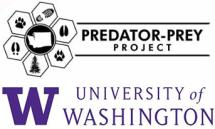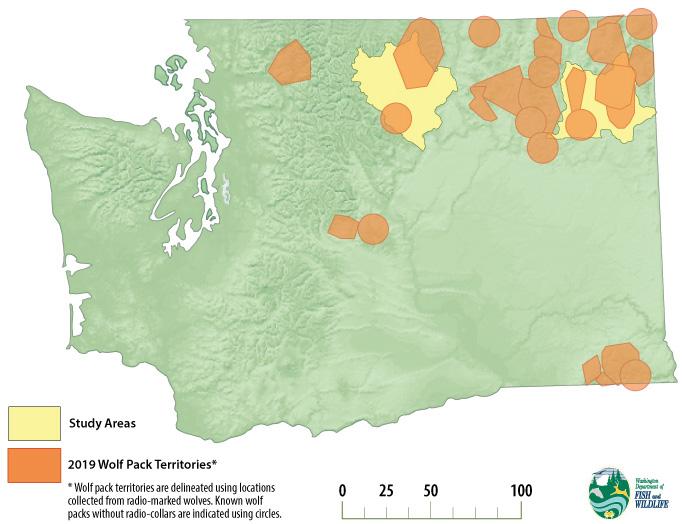
The Washington Predator-Prey Project is a five-year research effort that began in the winter of 2016-17 to investigate the effects of wolves and their competitors on ungulate populations in managed landscapes. The project studied the impact to ungulates (mule deer, white-tailed deer, and elk) from wolves that colonized areas where they live, as well as other large and small carnivores such as cougars, bobcats, and coyotes.
WDFW scientists collaborated with professors and graduate students from the University of Washington (UW) on this project, focusing their efforts in two study areas with varying levels of wolf presence in Stevens, Pend Oreille, and Okanogan counties. Within these study areas, researchers outfitted deer, elk, wolves, cougars, coyotes, and bobcats with GPS radio collars to obtain information on the survival, sources of mortality, productivity, movements, distribution, and resource use of both predators and prey. Researchers also deployed motion-sensing cameras and audio recorders to collect information on the behavior, interactions, and activity of predators and prey across space and time, and to test the utility of these non-invasive techniques to survey predator and prey populations,
Information gathered through this process provides a greater understanding of predator-prey dynamics in communities with wolves, including the impacts of predation on ungulate populations.
This video illustrates how results of the Predator-Prey Project will be used to help inform wildlife management decisions.
What is Washington’s Predator-Prey Project Aimed at Achieving?
- Assessing the effects of predation on ungulate populations in managed landscapes with wolves.
- Determining the degree of influence wolves have on cougar space use, foraging ecology, and population dynamics.
- Using the findings to address predator-prey and species-specific objectives outlined in WDFW’s 2016-2021 Game Management Plan.
- Obtaining a greater understanding of Washington’s complex predator-prey communities for their improved conservation and management.

What has been done?
In the spring of 2019, researchers achieved all of their collaring targets for ungulates and cougars in both areas of the study. In the Okanogan, researchers collared mule deer, and in Stevens and Pend Orielle counties, they collared elk and white-tailed deer. In both study areas, wolves, cougars, coyotes, and bobcats were collared for the study. Collaring efforts for the project were completed during spring 2020 and researchers. Total ungulates collared include:
| Species | Adult | Juvenile |
|---|---|---|
| Mule deer* | 149 | |
| White-tailed deer | 131 | 97 |
| Elk | 63 | 20 |
In addition to the collars, 100 trail cameras and over 150 audio recorders were distributed across the project study areas. For questions or more information on the Washington Predator-Prey Project, email wildthing@dfw.wa.gov and visit the Predator-Prey Project website maintained by collaborators from the University of Washington.
* Researchers are not collaring mule deer fawns for the project and focusing capture efforts for juveniles in the most eastern of the two study areas.
Learn more/study results
More information on the Washington Predator Prey Project can be found in multiple publications on the study.